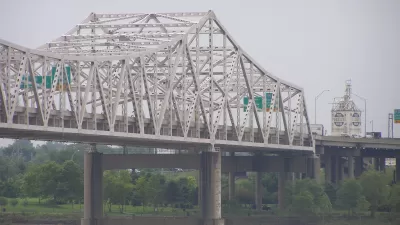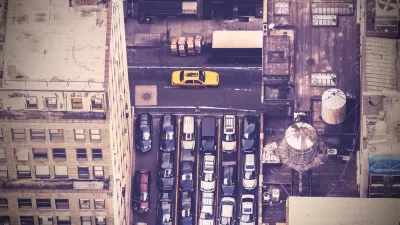To cure chronic traffic congestion, U.S. cities should consider a prescribed treatment approach, using technology and road pricing strategies to target the root cause instead of just managing the symptoms.

In the bustling arteries of our modern urban areas, traffic congestion continues to suffocate growth and progress while stifling quality of life. What was once an occasional inconvenience has become a chronic affliction, strangling economic growth, amplifying pollution, and testing the patience of commuters, business owners, and residents alike. The challenges posed by traffic congestion are multifaceted, presenting a complex puzzle that demands innovative solutions.
The growing grip of traffic congestion
Traffic congestion has evolved from a localized issue to a systemic barrier to growth. In major urban centers around the world, it's not uncommon for commuters to spend hours navigating clogged roads, inching forward amid a sea of brake lights. This congestion isn't just frustrating; it's also expensive. Studies show that congestion costs billions of dollars annually in lost productivity, wasted fuel, and increased transportation costs.
Recently, New York City came under the spotlight when it decided at the last minute to ditch a plan to implement “congestion pricing,” a local toll that was met with much resistance from local commuters and businesses.
According to industry observers, traffic congestion and the associated delays cost the U.S. economy over $120 billion annually. Another study showed that in 2022, U.S. traffic congestion resulted in the average driver spending 51 hours in traffic, equating to approximately $869 in lost time and increased pollution.
Traffic congestion’s threat to urban prosperity
Congestion poses a direct threat to the very fabric of what makes for a thriving urban environment. From an economic standpoint, local businesses struggle with delayed deliveries and increased transportation expenses, leading to higher prices for consumers. Moreover, the allure of urban centers as hubs of innovation and commerce diminishes when the promise of accessible mobility is overshadowed by endless traffic snarls. Investors and entrepreneurs think twice about establishing roots in cities in which gridlock reigns supreme.
The impact of congestion extends beyond economic realms as well, seeping into the fabric of everyday life. Residents face heightened stress levels because of longer commutes and unpredictable travel times. Air quality deteriorates as engines idle in perpetual traffic, exacerbating respiratory issues and environmental concerns. Pedestrians and cyclists, essential components of vibrant urban landscapes, are sidelined by congested roads that prioritize cars over alternative modes of transport.
Innovative treatments for traffic congestion
Traffic congestion is not unlike congestion that builds up in the human airways. When we see a doctor, we are prescribed a treatment that clears the backup. Similarly for roads, rather than setting up road signs and cones to redirect traffic, cities can take a more prescribed treatment approach through methods such as congestion pricing and other road pricing strategies, as well as technologies like edge computing, navigation-enabled Mobility-as-a-Service (MaaS) modeling, and transit signal prioritization.
Transit signal prioritization in particular has a lot of promise in treating traffic congestion. This innovative technology leverages cloud-based and AI-powered real-time data and smart algorithms to treat acute symptoms and optimize traffic flow, giving priority to public transport vehicles such as buses, emergency first responders, and — in northern climates — snowplows, and reducing delays at intersections.
By improving the reliability and speed of buses, this technology also treats congestion systematically by incentivizing commuters to choose sustainable transport options over private vehicles. This shift alleviates overall congestion, freeing up road capacity and reducing emissions. In essence, transit signal prioritization is a catalyst for a more balanced, efficient urban mobility ecosystem.
‘Whole-body’ approach for traffic congestion, powered by AI
To combat the scourge of congestion and unlock urban potential, cities must prioritize innovation in transportation management. Embracing platforms like transit signal prioritization represents just one piece of a larger puzzle. Integrated approaches that blend public transit enhancements with policies promoting shared mobility, cycling infrastructure, and urban planning reforms are essential.
Key to the success of this approach is the integration of traffic signals and intersections with the flow of traffic, which of course changes based on events, work hour vehicle demand, weather patterns (evacuations, etc.), and the prioritization of emergency response vehicles that need to move freely through certain corridors to get to an injured person or fire, for example. Much of this is already in use in several cities across the U.S., all driven by AI.
AI promises to streamline traffic flow and reduce congestion for many of today’s busiest roadways and thoroughfares. Smart traffic light systems and the cloud technology platforms they operate on are now designed to manage and predict traffic more efficiently, which can save a lot of money and create more efficiencies not only for the cities themselves, but for individuals also.
AI and machine learning today can process highly complex data and traffic trends and suggest optimum routing for drivers in real-time based on specific traffic conditions. By integrating everyone’s real-time routing information, cloud-based traffic management systems can now optimize traffic light timing to the true needs of traffic. Additionally, since there is no need for expensive hardware additions or buildouts, city budgets are not expected to expand.
The results are speaking for themselves
In 2023, an analysis by LYT, a provider of cloud-based open-architecture smart traffic solutions, of intersections throughout the U.S. found that transit signal prioritized intersections saved a total of $569,300 in fuel costs, representing an almost 14 percent reduction over the previous year. The technology saw reduced transit bus CO2 emissions by over 1,150 metric tons, and saved 9,107 hours or 54 weeks by reducing red light wait times for transit buses (a 48 percent reduction with TSP than without).
Today’s recognition algorithms offer enhanced insight on the mix of density, traffic, and overall rate of flow. Furthermore, these optimized algorithms can leverage data points by region resulting in a streamline pattern to reduce traffic problems while redistributing flow more optimally. Municipal traffic management systems can then make better decision-making power, and the control system has a much higher degree of failure tolerance as was previously demonstrated in legacy hub-and-spoke systems.
Traffic congestion represents a formidable challenge for cities worldwide, imperiling economic growth and eroding quality of life. However, this challenge is not insurmountable. By embracing innovative solutions like transit signal prioritization and fostering holistic approaches to mobility management, cities can break free from the grip of gridlock. The road to congestion-free cities is paved with innovation, collaboration, and a collective commitment to reclaiming our streets for the prosperity and well-being of all. Let us seize this opportunity to redefine urban mobility and revitalize our cities for generations to come.
Timothy Menard is the Founder and CEO of LYT.

Alabama: Trump Terminates Settlements for Black Communities Harmed By Raw Sewage
Trump deemed the landmark civil rights agreement “illegal DEI and environmental justice policy.”

Study: Maui’s Plan to Convert Vacation Rentals to Long-Term Housing Could Cause Nearly $1 Billion Economic Loss
The plan would reduce visitor accommodation by 25% resulting in 1,900 jobs lost.

Planetizen Federal Action Tracker
A weekly monitor of how Trump’s orders and actions are impacting planners and planning in America.

Federal Homelessness Agency Places Entire Staff on Leave
The U.S. Interagency Council on Homelessness is the only federal agency dedicated to preventing and ending homelessness.

Restoring Northern India’s Himalayan ‘Water Temples’
Thousands of centuries-old buildings protect the region’s natural springs and serve as community wells and gathering places.

Milwaukee to Double Bike Share Stations
Bublr Bikes, one of the nation’s most successful, will add 500 new e-bikes to its system.
Urban Design for Planners 1: Software Tools
This six-course series explores essential urban design concepts using open source software and equips planners with the tools they need to participate fully in the urban design process.
Planning for Universal Design
Learn the tools for implementing Universal Design in planning regulations.
Caltrans
Smith Gee Studio
Institute for Housing and Urban Development Studies (IHS)
City of Grandview
Harvard GSD Executive Education
Toledo-Lucas County Plan Commissions
Salt Lake City
NYU Wagner Graduate School of Public Service





























